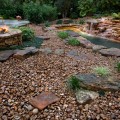Tips on Drought Resistant Trees
Using drought resistant trees in your yard is one of the best ways to protect your investment in Houston landscaping design.
Your home will have much more lasting curb appeal if your trees are healthy, green, and vibrant regardless of weather conditions. It can also save a tremendous amount of money in landscaping maintenance by minimizing the amount of watering your lawn will require during hot summer months with little or no rain.
Because urban environments feature dense populations, mechanization, exhausts from industries and vehicles, and massive amounts of steel, glass, and concrete, they are typically much hotter than surrounding rural areas. Prolonged high temperatures without rain can devastate the tree life in Houston more quickly than nearby Brazos Bend State Park. This is why it is wise to plan on adding drought resistant trees to your yard, because you never know when the next heat wave will strike.
Resistance to drought, by definition, does not mean something that only grows in a desert. The definition is much broader than that. Resisting drought conditions has more to do with how efficiently a tree manages water than it does with where it originates in the world. As such, the ability to go several months without rain in an environment like ours that normally gets plenty of rain is even more valuable than a plant that grows only in arid regions of the world in relative isolation. Finding the rights species of trees that can thrive in both normal and abnormal rainfall levels represents the ideal investment in a new outdoor living experience.
The good news is that there are lots of choices when it comes to selecting drought resistant trees. For any given style of landscaping, there are scores of species that can fulfill the aesthetic and functional requirements expected of them.
There are also drought resistant trees that create a large amount of shade beneath a very thick canopy that grows in multiple layers of branches and leaves. These include oaks, soft maples, walnuts, and pines. Other trees are better suited to partial shade near outdoor kitchens, homes, or near larger trees. These species, such as maple, redwood, and magnolia, create a single layer canopy that is much more basic in appearance and more appropriate to using as accents to other Houston landscaping elements.
Both types of drought resistant trees have their proper place on the landscape. In larger yards where the hot sun bakes the land for most of the day, multilayered canopy trees are typically used to create shaded areas over patios, courtyards, and outdoor buildings. Their tendency to grow taller than they are wide also contributes a much needed vertical impact to an otherwise vast expanse of yard. This has the effect of making the entire area appear more uplifted when viewed from a distance.
Mono-layered trees are highly prized for the mid-growth aesthetic they contribute to patios, walkways, and garden designs. Sometimes they are also used to build tree walls around seating areas to give occupants a much needed sense of retreat from the outside world. Their efficient use of sunlight, combined with their efficient management of limited water, makes them ideal for any number of areas where larger trees cannot grow, but where vertical impact, organic vitality, and color are still needed to complete the scene.
You do not have to be an expert in drought resistant trees, or even know which species technically fall into this category, to benefit from their addition to your yard. Houston landscaping designers from Exterior Worlds will guide your choices and help you integrate the very best options for you. Your home will gain immediate curb appeal from the combination of superior aesthetic combined with lower maintenance that they bring to your property.

